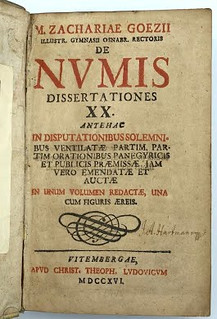
PREV ARTICLE
NEXT ARTICLE
FULL ISSUE
PREV FULL ISSUE
FR. ATHANASIUS KIRCHER, S. J. (1602-1680)John Lupia submitted the following information from the online draft of his book of numismatic biographies for this week's installment of his series. Thanks! As always, this is an excerpt with the full article and bibliography available online. This week's subject is early numismatic author Athanasius Kircher. -Editor
At a young age he exhibited a fascination and keen interest in geology. From 1614-1618, he was educated at Fulda in the Jesuit College. From 1618-1622, he studied in the Jesuit novitiate. In 1628, he was ordained a priest in the Society of Jesus. Among the many fields of endeavor of Fr. Athanasius Kircher, S. J., one field of activity was as an early epigrapher, i.e., a scholar in the first half of the seventeenth century who attempted to work out the puzzle of messages of unknown ancient languages found in various inscriptions in various media like stones, medals, and coins based on clues of site origin where they were found and/or context. The lack of a pre-existing infrastructure containing a wealth of data to draw from in his day explains his obvious failures and hardly detract from his many accomplishments that have contributed to a fuller picture of subjects in several disciplines. Consequently, it was only natural that he would have misinterpreted some inscriptions like the one found on an ancient Cyprian scarab which he mistook in his Prodromos Coptus (Rome, 1636) as Coptic because of its scarab design having been associated with Egyptian art and archaeology by earlier writers like Ulisse Aldrovandi. His later volumes on Hieroglyphs from 1650-1654 were a similar attempt which demonstrates an intellectual with a flair for problem solving working in a vacuum attempting to solve the riddle of the ancient hieratic pictograms. Its quite O.K. to have failed at something so original and monumental a task over 150 years before Bouchard's discovery of the Rosetta Stone in 1799 that took more than two decades later to be deciphered by J-F Champollion in 1822. It is very probable that Kircher's errors helped to guide the way for Champollion. Fr. Kircher wrote mainly on Roman coins. In the field of numismatic studies their is paucity of any work and to date the best reference is found in John Edward Fletcher, A Study of the Life and Works of Athanasius Kircher, ‘Germanus Incredibilis’. (Brill, 2011) : 182 Fletcher refers to the published letters of Zacharias Goetz (1662-1716), that pertain to Fr. Kircher's numismatic research. Additionally to the work of Francisco Perez Bayer (1711-1794), De nummis Hebraeo-Samaritanis, which gives two references to Kircher. However, it should be noted that a bibliographic citation to the numismatic related writings of Fr. Kircher was published in Lipsius', Bibliotheca Numuaria, page 209 with the entry - Kircheri (Athan.) Latium, i. e., nova et parallela Latii novi et veteris Descriptio, qua quaecumque vel natura, vel veterum Romanorum ingenium admiranda efficit. . . (Amsterdam, 1671), containing maps and plates, citing Numismata Sepulchrorum; Fortuna in numis.; Numismata Centronii. Lipsius also cites a second book, Principia Christiani archetypon politicum, etc. (Amsterdam, 1672). 
Plate of six Roman coins from Abruzzi region at Lake Fucino in Chapter VIII, Oppidum Sancti Viti, in Kircher's, Latium, i. e., nova et parallela . . . (Amsterdam, 1671), page 189 From this paucity or dearth of any serious research on the numismatic works of Fr. Kircher a doctoral dissertation or two would certainly contribute to a more detailed portrait. 

The modern Athanasius Kircher bronze medal was designed in 1976 for his tricentennial by sculptress Frédérique Maillart.
To read the complete article, see:
We have at least one other reference to Athanasius Kircher in The E-Sylum and surprisingly, it's not about a book. The reverse of the medal pictured above seems to show a labyrinth, which is also the subject of a 2016 Cook Island coin design. Since it's non-numismatic I'll leave the background on Kircher's Labyrinth as an exercise for the reader. -Editor "The reverse depicts the Egyptian Labyrinth of Athanasius Kircher and features a playable micro- labyrinth inlay in the centre. Engraved are the inscriptions MILESTONES OF MANKIND, EGYPTIAN LABYRINTH, and the year of issue."
To read the earlier E-Sylum article, see:

Wayne Homren, Editor The Numismatic Bibliomania Society is a non-profit organization promoting numismatic literature. See our web site at coinbooks.org. To submit items for publication in The E-Sylum, write to the Editor at this address: whomren@gmail.com To subscribe go to: https://my.binhost.com/lists/listinfo/esylum All Rights Reserved. NBS Home Page Contact the NBS webmaster 
|

